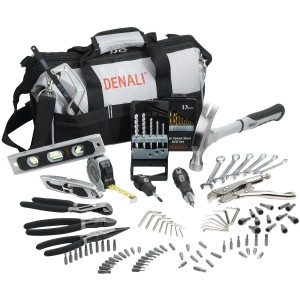It’s tough to implement a philosophy. Most of us whether we care to admit it or not were introduced to Lean, Six Sigma and even Design Thinking through a set of tools. I have written two posts on this subject, a guest blog post on Tim McMahon’s Lean Journey blog titled, Lean Sales and Marketing – Not without a new Toolset!. 
I have always encouraged manufacturing organizations that if they could learn the Seven Basic Quality they could go a long way in their improvement efforts. These tools were first emphasized by Kaoru Ishikawa, a professor of engineering at Tokyo University and the father of “quality circles.” The seven tools are:
- Cause-and-effect diagram (also called Ishikawa or fishbone chart): Identifies many possible causes for an effect or problem and sorts ideas into useful categories.
- Check sheet: A structured, prepared form for collecting and analyzing data; a generic tool that can be adapted for a wide variety of purposes.
- Control charts: Graphs used to study how a process changes over time.
- Histogram: The most commonly used graph for showing frequency distributions, or how often each different value in a set of data occurs.
- Pareto chart: Shows on a bar graph which factors are more significant.
- Scatter diagram: Graphs pairs of numerical data, one variable on each axis, to look for a relationship.
- Stratification: A technique that separates data gathered from a variety of sources so that patterns can be seen (some lists replace “stratification” with “flowchart” or “run chart”).
Excerpted from Seven Basic Quality Tools by ASQ Quality Press
In 1976, the Union of Japanese Scientists and Engineers (JUSE) saw the need for tools to promote innovation, communicate information and successfully plan major projects. A team researched and developed the seven new quality control tools, often called the seven management and planning (MP) tools, or simply the seven management tools. Not all the tools were new, but their collection and promotion were. The seven MP tools, listed in an order that moves from abstract analysis to detailed planning, are:
- Affinity diagram: organizes a large number of ideas into their natural relationships.
- Relations diagram: shows cause-and-effect relationships and helps you analyze the natural links between different aspects of a complex situation.
- Tree diagram: breaks down broad categories into finer and finer levels of detail, helping you move your thinking step by step from generalities to specifics.
- Matrix diagram: shows the relationship between two, three or four groups of information and can give information about the relationship, such as its strength, the roles played by various individuals, or measurements.
- Matrix data analysis: a complex mathematical technique for analyzing matrices, often replaced in this list by the similar prioritization matrix. One of the most rigorous, careful and time-consuming of decision-making tools, a prioritization matrix is an L-shaped matrix that uses pairwise comparisons of a list of options to a set of criteria in order to choose the best option(s).
- Arrow diagram: shows the required order of tasks in a project or process, the best schedule for the entire project, and potential scheduling and resource problems and their solutions.
- Process decision program chart (PDPC): systematically identifies what might go wrong in a plan under development.
Excerpted from Nancy R. Tague’s Quality Toolbox ; Second Edition, ASQ Quality Press, 2004.
Today’s world has introduced more and more uncertainty. As a result it has forced us to get closer and closer to our customers. This reduces are reaction time and allows us to make better informed decisions. To do this, once again a new set of tools need to be utilized. This methodology has been introduced to us through the concepts of Design Thinking. This set of tools:
- Visualization: using imagery to envision possible future conditions
- Journey Mapping: assessing the existing experience through the customer’s eyes
- Value Chain Analysis: assessing the current value chain that supports the customer’s journey
- Mind Mapping: generating insights from exploration activities and using those to create design criteria
- Brainstorming: generating new alternatives to the existing business model
- Concept Development: assembling innovative elements into a coherent alternative solution that can be explored and evaluated
- Assumption Testing: isolating and testing the key assumptions that will drive success or failure of a concept
- Rapid Prototyping: expressing a new concept in a tangible form for exploration, testing, and refinement
- Customer Co-Creation: enrolling customers to participate in creating the solution that best meets their needs
- Learning Launch: creating an affordable experiment that lets customers experience the new solution over an extended period of time, so you can test key assumptions with market data
Excerpted from Designing for Growth: A Design Thinking Toolkit for Managers (Columbia Business School Publishing).
Along with these basic tools, I believe that Osterwalder’s Business Model Generation Template, the Lean A3 thinking tool and Kanban are integral parts in today’s marketing bag of tools. Notwithstanding there are other traditional marketing tools, but these are the tools of continuous improvement and quality. I think all 27 tools mentioned could be utilized under the correct circumstance. Many of them are already familiar to us and require a very small learning curve. I would have a tendency to work them backwards introducing the Design Thinking set first and then the Seven MP Tools and finally the Seven Basic Quality Tools. If you had limited knowledge of them, this would allow the best way to grow into them. If you are knowledgeable about one set of them, by all means use them. For example, a checklist is a checklist.
It’s tough to be a carpenter if you don’t know when to use a rip saw versus a cross-cut. The mastery of these set of tools provide a solid foundation for implementing continuous improvement in your sales and marketing.
Related Information:
Best in Market eBook
Value Stream Mapping
Lean Marketing
Dominating Markets with Value: Advances in Customer Value Management
